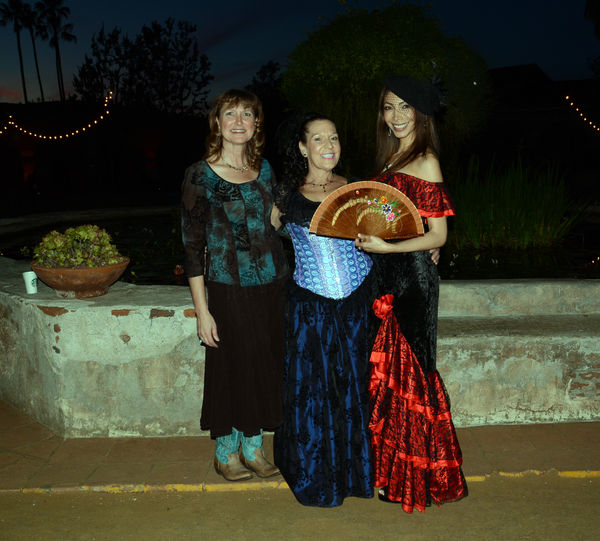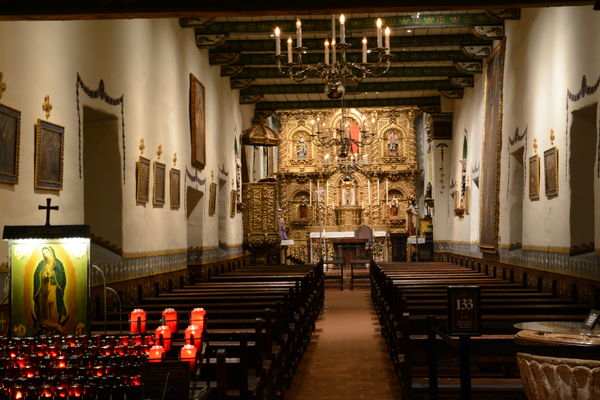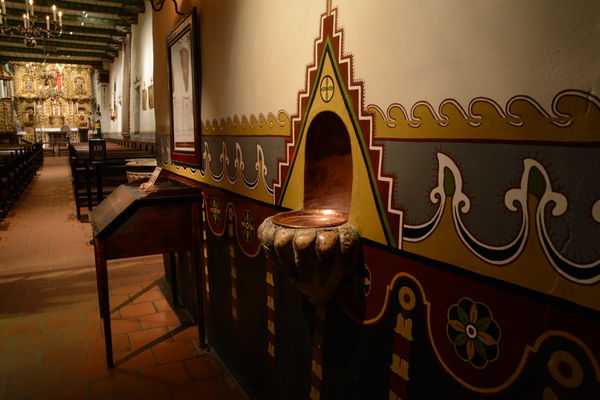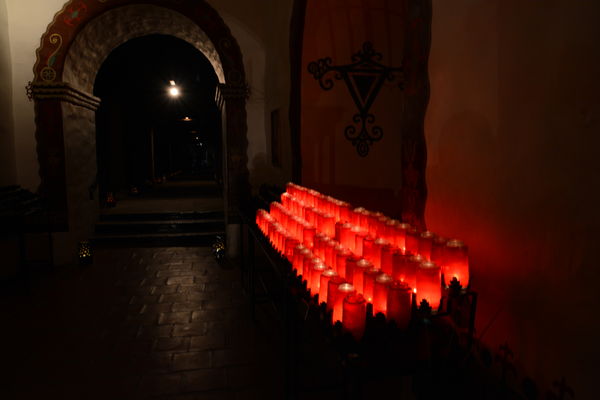San Juan Mission. Low light
Apr 6, 2015 10:10:06 #
What settings do you use in-doors for Low light.
I'm learning a lot from all of you here.
It's very much appreciated.
Here's are some shots from an event I was at.
They use this for weddings.
I'm learning a lot from all of you here.
It's very much appreciated.
Here's are some shots from an event I was at.
They use this for weddings.
Apr 6, 2015 11:08:00 #
Hey Mark,
Can I ask you how you had your camera set? (mode, metering, etc?) The reason I'm asking is that shooting in low light is tricky and I've often found that using a programmed mode is actually harder to get the proper exposure, than using manual. (just my personal experience)
Let us know how you normally set up (or how you set up for this event) and I'm sure we can help you out with exposure.
Thanks
bk
Can I ask you how you had your camera set? (mode, metering, etc?) The reason I'm asking is that shooting in low light is tricky and I've often found that using a programmed mode is actually harder to get the proper exposure, than using manual. (just my personal experience)
Let us know how you normally set up (or how you set up for this event) and I'm sure we can help you out with exposure.
Thanks
bk
Apr 6, 2015 12:02:24 #
bkyser wrote:
Hey Mark,
Can I ask you how you had your camera set? (mode, metering, etc?) The reason I'm asking is that shooting in low light is tricky and I've often found that using a programmed mode is actually harder to get the proper exposure, than using manual. (just my personal experience)
Let us know how you normally set up (or how you set up for this event) and I'm sure we can help you out with exposure.
Thanks
bk
Can I ask you how you had your camera set? (mode, metering, etc?) The reason I'm asking is that shooting in low light is tricky and I've often found that using a programmed mode is actually harder to get the proper exposure, than using manual. (just my personal experience)
Let us know how you normally set up (or how you set up for this event) and I'm sure we can help you out with exposure.
Thanks
bk
Hey, thanks very much for your asking and your help.
I use aperture priority. with my 7100.
I'm actually getting a 750 in the near future.
I was using my Sigma 17-70 lens.
I really love that lens.
I was using ISO 640 inside the church. f-9
ISO 500 outside in the courtyard with the on board flash.
I'm planning on getting some quality lighting soon.
Thanks to all of you here for your advise and help.
Apr 7, 2015 09:18:30 #
OK, thanks. First thing I see is that with a 7100 (my main body is a 7100, back up is a 7000) Don't be afraid to push up the ISO to 1600, (I have done higher and didn't experience enough noise to concern me, but 1600 is my typical maximum) You will have more of a noise issue with under exposing an image and trying to recover, than you will if you use a higher ISO and properly expose.
The auto modes (like Aperture) are useful, and I never put anyone down for using them, but you need to use exposure compensation because those modes are easily fooled. One thing to do is change to spot metering, and at least your subject will be metered properly. Of course, if you focus on a candle flame, that all goes out the window.
Here's where an inexpensive hand held meter comes in REALLY handy. It meters the ambient light, as well as the flash if you use it that way. If you meter the ambient light (not reflected, the incident metering with the dome) it isn't fooled by things like candles or a lot of white or black in a room. It just reads the light falling wherever the dome is.
When you say "on board" flash, do you mean a separate flash in the hot shoe, or the flash built in to the camera. If it is the built in flash, yes, you really need a different flash, they just aren't powerful enough.
To get a flash that sits in the hot shoe, or better yet, bracket, or best, on a stand that you can move around (but have an assistant to guard people from knocking it over) Get a TTL flash (even an off name, I use Nikon, but my business partner swears by Yongnuo and Meike brands...I admit, they are easy to use...just make sure they are TTL) Get TTL triggers, I do use the Yongnuo 622n's and 622N TX trigger system.
Slowing down the shutter speed will let in a lot more ambient light. If you try to just blast the light to fill the room, you will just end up with the people in the shot being over blown, and the rest of the room still looking dark.
Think of it like this. Shutter speed controls how much of the room is lit. Flash should be used to make the subjects "pop" I like to get the room about 1/2 to 1 stop under exposed, and the people to be lit properly with the flash. If the people are too bright, close down your aperture, if they are too dark, open up the aperture.
Aperture controls how much of the flash (which is only lighting your subjects) hit the sensor.
This is how I can take a low key portrait of a person, standing in front of a white seamless backdrop, but it looks like they are standing in front of a black backdrop.
HOW? I first raise my shutter speed above high speed sync speed (in our case, sync speed would be 1/250.... I raise it to like 1/600) If you snap a no flash photo now, your photo would be black. Set up an off camera flash (you can't aim the flash right at the backdrop, it would hit at an angle, and miss the backdrop, which also makes for better lighting and shadows on the face) Now take a photo with the flash. If the face is too bright, close the aperture, if it is doo dark, open the aperture. You can also adjust the flash brightness, but I prefer to set it about 50% and let my aperture do the work. Saves batteries, and also recycles a lot faster.
So.....long story longer :-) To take photos of people in darker locations like what you were trying to do... Just slow your shutter speed down, 1/60 or slower to allow more light in. Your flash is milliseconds fast many times faster than any shutter speed, so the subjects (only thing lit by the flash) should be frozen and not have motion blur.
You just need to have an IS lens, or better yet, use a tripod to stop seeing motion blur in the background.
One last thing, sometimes when shooting in a church or other venues, they will have a very strong yellow cast to the photos. The only real way to properly white balance is to use a CTO (Color Temperature Orange) gel on the flash. Then the flash is the same color as the incandescent bulbs, and then your white balance is cake. Nothing looks worse and more amateurish than a bunch of mixed lighting. There is also a gel available for fluorescent lighting, the name is escaping me now, but it is green. (maybe that's it....Color Temperature Green CTG?)
Good luck, and I hope to be seeing some more images from you soon. I hope I didn't try to give you too much, too soon.
The auto modes (like Aperture) are useful, and I never put anyone down for using them, but you need to use exposure compensation because those modes are easily fooled. One thing to do is change to spot metering, and at least your subject will be metered properly. Of course, if you focus on a candle flame, that all goes out the window.
Here's where an inexpensive hand held meter comes in REALLY handy. It meters the ambient light, as well as the flash if you use it that way. If you meter the ambient light (not reflected, the incident metering with the dome) it isn't fooled by things like candles or a lot of white or black in a room. It just reads the light falling wherever the dome is.
When you say "on board" flash, do you mean a separate flash in the hot shoe, or the flash built in to the camera. If it is the built in flash, yes, you really need a different flash, they just aren't powerful enough.
To get a flash that sits in the hot shoe, or better yet, bracket, or best, on a stand that you can move around (but have an assistant to guard people from knocking it over) Get a TTL flash (even an off name, I use Nikon, but my business partner swears by Yongnuo and Meike brands...I admit, they are easy to use...just make sure they are TTL) Get TTL triggers, I do use the Yongnuo 622n's and 622N TX trigger system.
Slowing down the shutter speed will let in a lot more ambient light. If you try to just blast the light to fill the room, you will just end up with the people in the shot being over blown, and the rest of the room still looking dark.
Think of it like this. Shutter speed controls how much of the room is lit. Flash should be used to make the subjects "pop" I like to get the room about 1/2 to 1 stop under exposed, and the people to be lit properly with the flash. If the people are too bright, close down your aperture, if they are too dark, open up the aperture.
Aperture controls how much of the flash (which is only lighting your subjects) hit the sensor.
This is how I can take a low key portrait of a person, standing in front of a white seamless backdrop, but it looks like they are standing in front of a black backdrop.
HOW? I first raise my shutter speed above high speed sync speed (in our case, sync speed would be 1/250.... I raise it to like 1/600) If you snap a no flash photo now, your photo would be black. Set up an off camera flash (you can't aim the flash right at the backdrop, it would hit at an angle, and miss the backdrop, which also makes for better lighting and shadows on the face) Now take a photo with the flash. If the face is too bright, close the aperture, if it is doo dark, open the aperture. You can also adjust the flash brightness, but I prefer to set it about 50% and let my aperture do the work. Saves batteries, and also recycles a lot faster.
So.....long story longer :-) To take photos of people in darker locations like what you were trying to do... Just slow your shutter speed down, 1/60 or slower to allow more light in. Your flash is milliseconds fast many times faster than any shutter speed, so the subjects (only thing lit by the flash) should be frozen and not have motion blur.
You just need to have an IS lens, or better yet, use a tripod to stop seeing motion blur in the background.
One last thing, sometimes when shooting in a church or other venues, they will have a very strong yellow cast to the photos. The only real way to properly white balance is to use a CTO (Color Temperature Orange) gel on the flash. Then the flash is the same color as the incandescent bulbs, and then your white balance is cake. Nothing looks worse and more amateurish than a bunch of mixed lighting. There is also a gel available for fluorescent lighting, the name is escaping me now, but it is green. (maybe that's it....Color Temperature Green CTG?)
Good luck, and I hope to be seeing some more images from you soon. I hope I didn't try to give you too much, too soon.
Apr 7, 2015 21:58:52 #
greg vescuso
Loc: Ozark,Mo.
bkyser wrote:
OK, thanks. First thing I see is that with a 710... (show quote)
Good information thanks for the explaination! :thumbup:
Apr 8, 2015 14:26:38 #
greg vescuso wrote:
Good information thanks for the explaination! :thumbup:
Just sorry it was so long winded. If it is any help at all, I'm glad to be of service.
I've had several slow months without much photography going on because of health issues. I just started booking (very late to get started for this year), and am chomping at the bit to get going again.
I think that's why I tend to get so long winded. It's just being anxious to put some of the things that I know, back to work.
Apr 12, 2015 20:27:13 #
bkyser wrote:
OK, thanks. First thing I see is that with a 710... (show quote)
Wow, 1600. Ok, I would have never tried that.
I will print this out and try these tips. Thanks so very much.
If you want to reply, then register here. Registration is free and your account is created instantly, so you can post right away.





